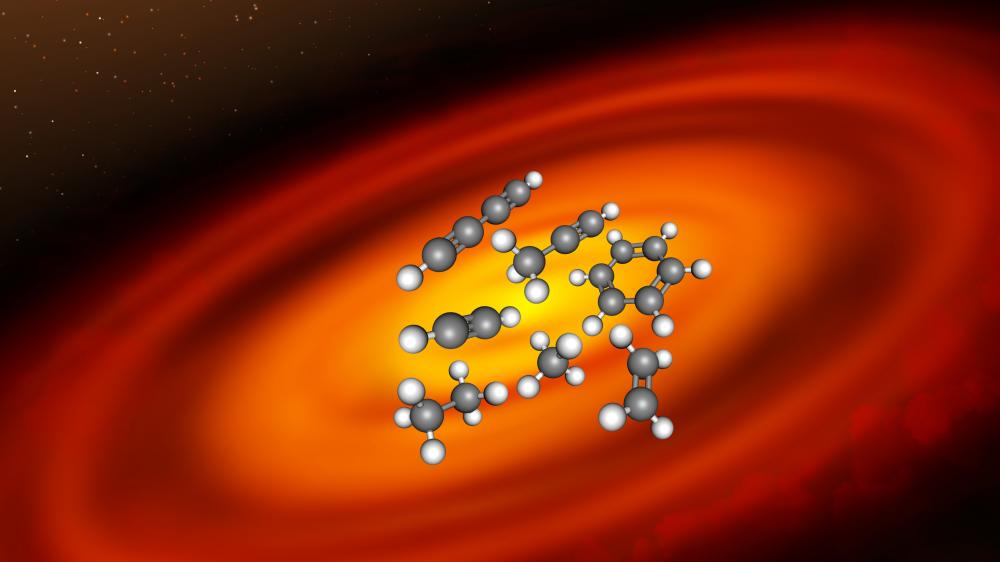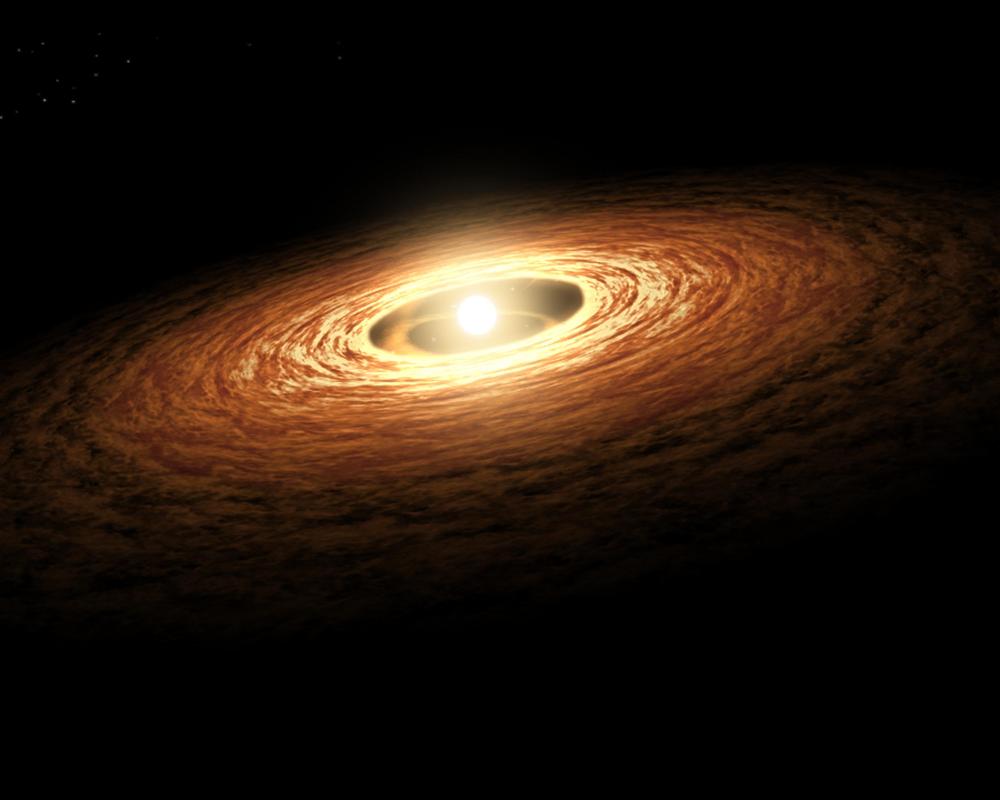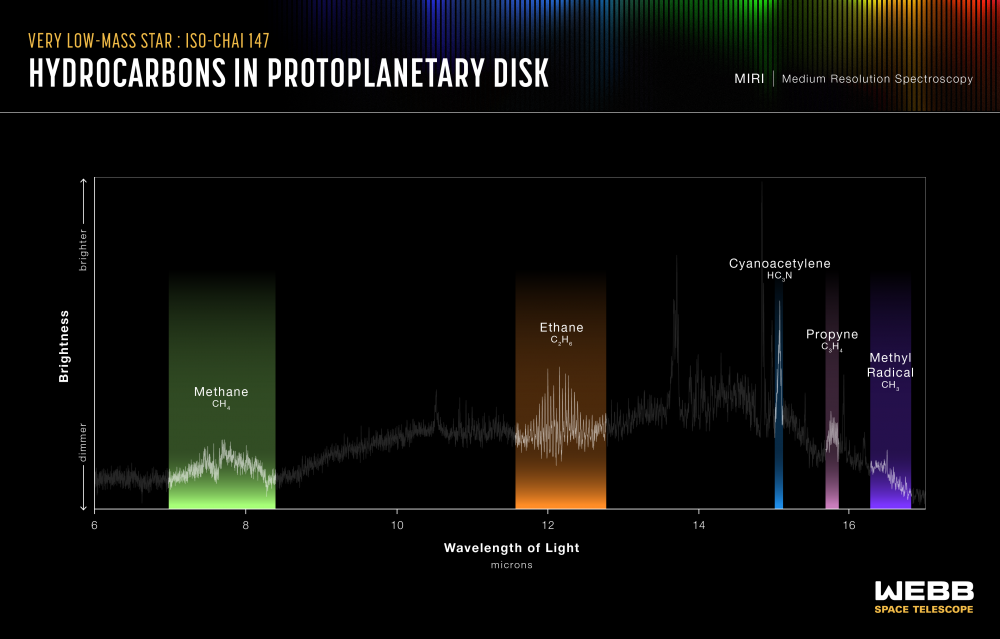Follow us on Google News (click on ☆)

Figure 1: Artist's impression of a protoplanetary disk around a very low-mass star. It represents a selection of hydrocarbon molecules (methane, CH4; ethane, C2H6; ethylene, C2H2; diacetylene, C4H2; propyne, C3H4; benzene, C6H6) detected in the disk around ISO-ChaI 147.
Credit: ALMA (ESO/NAOJ/NRAO) / MPIA
These discoveries have implications for the potential composition of planets forming around this star. The results, published in the journal Science on Thursday, June 6th, were obtained as part of the guaranteed time program of the MIRI instrument, developed by a consortium of laboratories in Europe and the United States.
The study of protoplanetary disks
Rocky planets are very common around very low-mass stars (less than 0.3 solar masses), as evidenced by the famous TRAPPIST-1 planetary system.
However, little is known about the chemistry of these worlds, which can be similar to or very different from Earth. By studying the disks from which these planets form, called protoplanetary disks, astronomers hope to better understand the planet formation process and the resulting composition of the planets.

Figure 2: Artist's impression of a young star surrounded by a disk of gas and dust.
Credit: NASA/JPL-Caltech
Protoplanetary disks around very low-mass stars (see Figure 2) are challenging to study because they are smaller and less luminous than the disks around more massive stars. The program called MIRI Mid-INfrared Disk Survey (MINDS) aims to leverage the unique capabilities of the James Webb Space Telescope (JWST) to correlate disk properties with exoplanet properties.

Figure 3: This graph represents the spectrum of the protoplanetary disk around the star ISO-ChaI-147 revealed by the MIRI (Mid-Infrared Instrument) of the James Webb Space Telescope. The spectrum shows the richest hydrocarbon chemistry observed to date in a protoplanetary disk, with 13 carbon molecules, including the first extrasolar detection of ethane (C2H6) and the first detection of ethylene (C2H4), propyne (C3H4), and methyl radical (CH3) in a disk.
Credits: NASA, ESA, CSA, Ralf Crawford (STScI)
A cocktail of molecules detected around the young star ISO-ChaI-147
In a new study, this team explored the region around a very low-mass star known as ISO-ChaI-147, a star aged 1 to 2 million years, whose mass is only 11% that of the Sun.
The spectrum revealed by the JWST's MIRI instrument shows the richest hydrocarbon chemistry observed to date in a protoplanetary disk—a total of 13 different carbon molecules (see Figure 3). The team notably detected ethane (C2H6) outside our solar system for the first time, as well as ethylene (C2H4), propyne (C3H4), and the methyl radical CH3.
"It is incredible that we can detect and quantify the amount of molecules we know well on Earth, such as benzene, in an object located more than 600 light-years away," explains Agnès Perrin, CNRS researcher at the Laboratoire de Météorologie Dynamique (LMD - CNRS/ENS-PSL/IPP/Sorbonne University).
"Last year, we already discovered a large amount of acetylene (C2H2), diacetylene (C4H2), and benzene (C6H6) in a disk around a similar star. Here, an even richer cocktail of molecules has been discovered, confirming that the disks around this type of star are true hydrocarbon factories," adds Benoît Tabone, CNRS researcher at the Institute of Space Astrophysics (IAS - University of Paris-Saclay/CNRS).
A more precise view of disks around very low-mass stars?
These results have important implications for the chemistry of the inner disk and the planets that could form there. As the JWST revealed that the gas present in the disk is rich in carbon, it is likely that there is little carbon left in the solid materials from which the planets would form. Consequently, the rocky planets that could form there would ultimately be poor in carbon.

Video of the spectrum of the protoplanetary disk of the star ISO-ChaI-147 captured by the JWST's MIRI instrument, showing the typical motion of the molecules responsible for absorption in the spectrum.
Credits: MPIA
This work highlights the crucial need for scientists to collaborate across various disciplines. The team notes that these results and the accompanying data can contribute to other fields, notably theoretical physics, chemistry, and astrochemistry, in order to interpret spectra and study new spectroscopic signatures of molecules in this wavelength range.